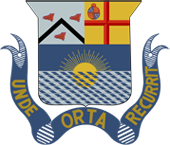
Presidency College is an art, commerce, and science college in the city of Chennai in Tamil Nadu, India. On 16 October 1840, this school was established as the Madras Preparatory School before being repurposed as a high school, and then a graduate college. The Presidency College is one of the oldest government arts colleges in India. It is one of two Presidency Colleges established by the British in India, the other being the Presidency College, Kolkata.

The National Gallery of Modern Art (NGMA) is the premier art gallery under Ministry of Culture, Government of India. The main museum at Jaipur House in New Delhi was established on 29 March 1954 by the Government of India, with subsequent branches at Mumbai and Bangalore. Its collection of more than 17,000 works by 2000 plus artists includes artists such as Thomas Daniell, Raja Ravi Verma, Abanindranath Tagore, Rabindranath Tagore, Gaganendranath Tagore, Nandalal Bose, Jamini Roy, Amrita Sher-Gil as well as foreign artists. Some of the oldest works preserved here date back to 1857. With 12,000 square meters of exhibition space, the Delhi branch is one of the world's largest modern art museums.
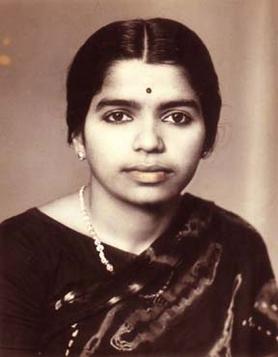
T. K. Padmini was an Indian painter from the south India state of Kerala. A recipient of multiple awards from the Chennai centre of the Lalit Kala Akademi, she was one of the prominent Indian woman painters. Her paintings have been displayed at The National Art Gallery, Salar Jung Museum, Hyderabad and the Durbar Hall Ground Art Gallery of Kerala Lalithakala Akademi. She died on 11 May 1969 at the age of 29.

Madras Medical College (MMC) is a public medical college located in Chennai, Tamil Nadu, India. Established in 1835, it is one of the oldest medical colleges in India, as well as in Asia.

Kanayi Kunhiraman is an Indian sculptor, best known for his outsize sculptures such as Yakshi of Malampuzha Dam Gardens, Sagarakanyaka at Shankumugham Beach and Mukkola Perumal trinity in Kochi. Taught by K. C. S. Paniker, he is a former chairman of the Lalit Kala Academy, India's national academy of fine arts. The Government of Kerala awarded him the inaugural Raja Ravi Varma Award in 2005. He is also a recipient of the Thikkurissy Award and the inaugural MS Nanjunda Rao National Award of the Karnataka Chitrakala Parishath. In 2022, he was honoured with Kerala Sree Award, third highest civilian award given by the Government of Kerala.

C. N. Karunakaran was an Indian painter, illustrator and art director from Kerala. He was the Chairman of the Kerala Lalitakala Academy and a recipient of several honours including the Kerala Lalithakala Akademi Award which he won thrice. The Akademi honoured him again with the fellowship in 2005.

Madathil Vasudevan, popularly identified as M. V. Devan, was an Indian painter, sculptor, writer, art critic and orator. Besides his artistic works, he was also known for his architectural designs for a number of cultural institutions as well as for his contributions in founding Kerala Kalapeetom, Kochi-based cultural organization, Malayala Kalagramam, an art village in New Mahe and Kalagramam, another art village in Kollam. A former chairman of the Kerala Lalithakala Akademi, he was a recipient of several honours including the Raja Ravi Varma Puraskaram of the Kerala Lalithakala Akademi, the Vayalar Award and the Mathrubhumi Literary Award.

Karuvattu Mana Vasudevan Namboothiri, better known as Artist Namboothiri or simply Namboothiri, was an Indian painter and sculptor, known for his line art and copper relief works. He illustrated for many Malayalam writers such as Thakazhy Shivasankara Pillai, Kesavadev, M. T. Vasudevan Nair, Uroob, S. K. Pottekkatt, Edasseri Govindan Nair, and V.K.N., and was one of the most prolific literary illustrators of India. He was also a chairman of the Kerala Lalithakala Akademi. The Akademi awarded him the Raja Ravi Varma Award in 2003. He was also a recipient of the Kerala State Film Award for Best Art Director.
K. M. Adimoolam was an Indian abstract artist. He was born in 1938 in Tiruchirapalli in Tamil Nadu. In 1959, he moved to Chennai where under the influence of the sculptor Dhanapal, he enrolled in the School of Arts and Crafts. After completing his Diploma in Advanced Painting in 1966, Adimoolam started a series of black and white portraits of Mahatma Gandhi. Sketching from photographs of the great man, he finished nearly a hundred drawings that moved over 60 years of the Mahatma’s life.
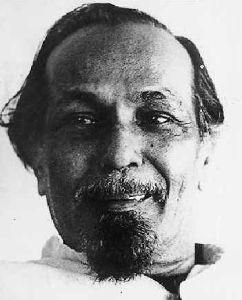
Kolozhi Cheerambathur Sankara Paniker was an Indian metaphysical and abstract painter from Malabar District. He interpreted the country's age-old metaphysical and spiritual knowledge in the 1960s, when Indian art was under the influence of the Western painters. "That was the time when a few Indian artists were trying to break out of this Western influence and establish an idiom and identity of their own", he said.

Akkitham Narayanan is a Paris-based Indian painter from Kerala. A student of such artists as K. C. S. Paniker, D. P. Roy Choudhury and Jean Bertholle, Narayanan's paintings are on display at various museums and galleries in many countries such as India, France, Japan, Poland and Germany. He is a three time recipient of the Tamil Nadu State Lalit Kala Akademi Award, Raja Ravi Varma Award of the Kerala Lalithakala Akademi and the Cagnes-sur-Mer International Festival of Painting Award.
Cholamandal Artists' Village is an artists' commune in Chennai, India. Established in 1966, it is the largest artists' commune in India. The community is located in the southern coastal neighborhood of Injambakkam. Its artists are credited for the Madras Movement of Art (1950s–1980s), which brought modernism to art in South India. Their work is widely recognized as some of the best art produced in postwar India and is shown regularly in galleries across the country. Several Cholamandal artists have also shown in Europe, the United States and South America.
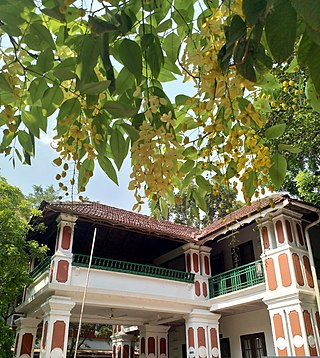
Government College of Fine Arts, Thrissur is located in the heart of the city of Thrissur in Kerala state of India. More than hundred years of existence has given a unique character to this institution in the history of art institutions in India. As a graduate level art college, this institution initiate young minds to work with the world of Art and Design and make a life in their own terms. As a Technical Commercial Industrial School, it was in 1910 that this institution started functioning. At that time, art education was basically an industrial training in order to produce skilled craftsmen and related vocational labors. During the second world war, the institution was renamed as ‘Government Trade School’. From 1943 to 1975, it was known as Government Occupational Institute. The fundamental shift from a vocational labor towards a more aesthetic ‘Fine Arts’ orientation occurred when it was upgraded as Govt.Institute of Fine Arts, in the year 1975. This was also about a raise and shift in the status of ‘artist’ in the modern sense of the term. In 1988 the title called National Diploma offered by this institute for its five year courses, gave training in Painting, Sculpture and Applied Art. In 2000, the status of this institute was raised as it got affiliated with the University of Calicut and started offering four year Bachelor of Fine Arts degree in three specialisations: Painting, Sculpture and Applied Arts. In the year 2019, a new course in Art History and Visual Studies has also started.
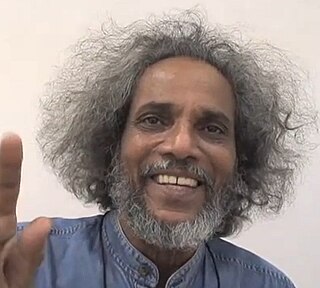
Velu Viswanathan, popularly known as Paris Viswanathan is an Indian painter, sculptor and filmmaker. He is considered by many as one of the prominent modern painters in India. He is a recipient of the Best Documentary Film Award of the Festival dei Popoli, Florence and the K. C. S. Paniker Award of the Kerala Lalithakala

The Triumph of Labour, also known as the Labour statue, is a statue at the Marina Beach, Chennai, India. Erected at the northern end of the beach at the Anna Square opposite University of Madras, it is an important landmark of Chennai. The statue shows four men toiling to move a rock, depicting the hard work of the labouring class. It was sculpted by Debi Prasad Roy Chowdhury. The statue is the earliest one to be erected on the beach and is installed close to the site where the country's first commemoration of May Day was held. The statue was installed on the eve of the Republic Day in 1959, as part of the Kamaraj government's drive to beautify the beach. The statue remains the focal point of May Day celebrations in the city.

Triveni Kala Sangam is an important cultural and arts complex and education centre in New Delhi. Founded in 1950, by Sundari K. Shridharani, who was also its Founding Director, Triveni, as it is commonly referred, contains four art galleries, a chamber theatre, outdoor theatre, open air sculpture gallery, besides this it runs its various arts, music and dance classes. It is situated on Tansen Marg, between Mandi House roundabout and Bengali Market.
Siramdasu Venkata Rama Rao is a British painter of Indian descent, known for his cubist paintings. Holder of Commonwealth Fellowship of 1962, he was honored by the Government of India, in 2001, with the fourth highest Indian civilian award of Padma Shri.
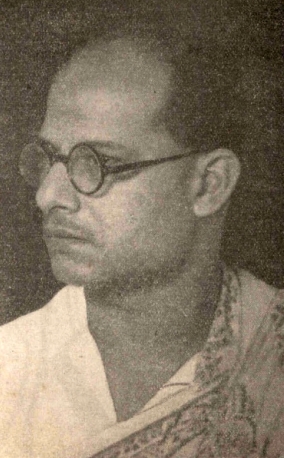
Devi Prasad Roy Choudhury was an Indian sculptor, painter and educator. He is well known for his monumental bronze sculptures, especially the Triumph of Labour and the Martyrs' Memorial, and is rated by many as one among the major artists of Indian modern art. He worked in a broad spectrum of mediums including watercolors, expressionist landscapes and commissioned portraits. Large scale sculptures were his particular strength and he made social realism the cornerstone of his art. In addition to painting and sculpting, he also wrestled, played the flute, engaged in hunting and wrote short stories in his spare time.

Parvathi Nayar is a New Delhi born visual artist and creative writer. She is best known for her creative videos, sculptures, paintings, bookmaking and photography. She was one of 70 artists selected to be part of B70, the historical 70th anniversary birthday show of Amitabh Bachchan. One of her works, a 20-foot-high drawn sculpture artwork, was installed at New Mumbai airport on the opening day ceremony in 2014. Her work has also been collected by Singapore Art Museum, Sotheby's Institute of Art, The Australia India Institute and Deutsche Bank.
S. Nandagopal was an Indian sculptor and painter, known for his sculptures in metal. He was one of the last members of the Madras Art Movement which pioneered modernism in art in south India and the son of K. C. S. Paniker, the founder of the movement as well as the Cholamandal Artists' Village. A two-time recipient of the Lalit Kala Akademi Award, Nandagopal was awarded the Jindal Stainless Steel Award for Sculpture in 2002.

















